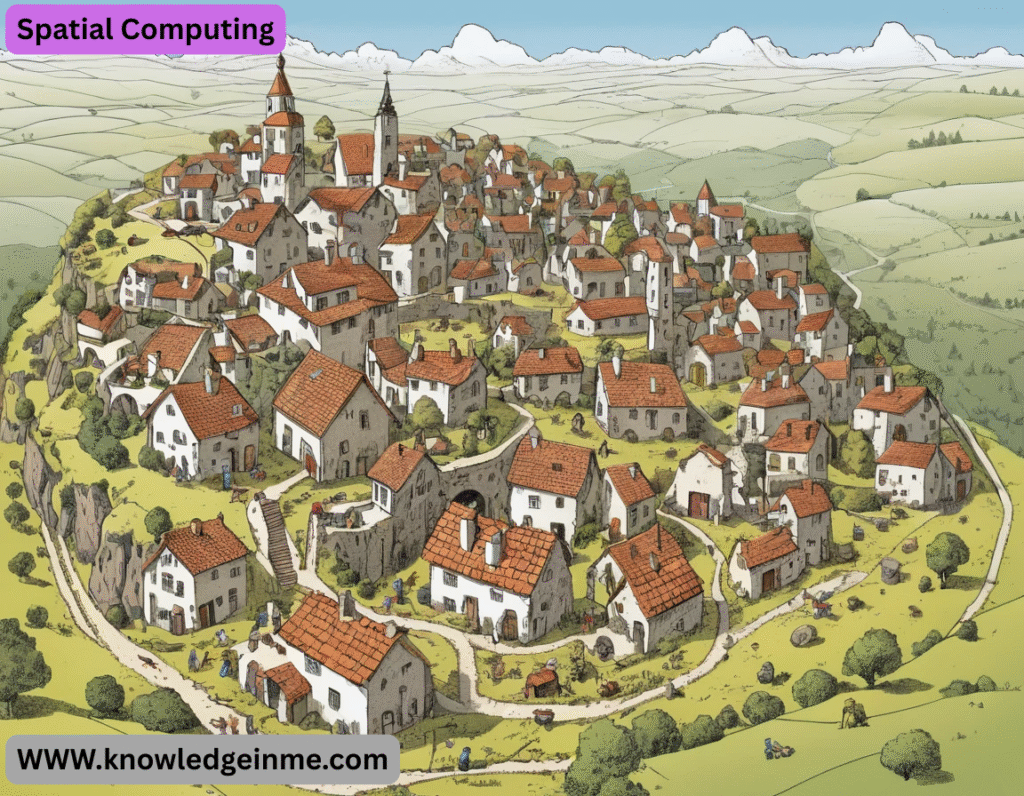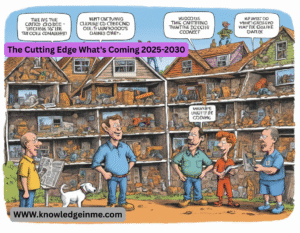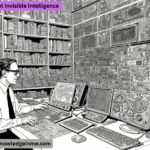Spatial Computing Spatial Computing is an evolving technology that blends the physical and digital worlds by enabling humans and machines to interact with each other and their environment in a spatially aware manner.

Key Components of Spatial Computing
- Spatial Mapping – Creates a 3D model of the physical environment to allow digital objects to interact realistically.
- Computer Vision – Helps devices recognize objects, surfaces, and gestures.
- Sensor Fusion – Combines data from cameras, LiDAR, IMUs, and depth sensors for accurate tracking.
- Artificial Intelligence (AI) – Powers object recognition, scene understanding, and predictive interactions.
- Human-Computer Interaction (HCI) – Enables natural input methods like hand tracking, eye tracking, and voice commands.
Applications of Spatial Computing
- Augmented Reality (AR) – Overlays digital content onto the real world (e.g., Apple Vision Pro, Microsoft HoloLens).
- Virtual Reality (VR) – Creates fully immersive digital environments (e.g., Meta Quest, HTC Vive).
- Mixed Reality (MR) – Merges real and virtual worlds for interactive experiences (e.g., Magic Leap, Microsoft Mesh).
- Industrial & Enterprise Use – Training simulations, remote assistance, and 3D design.
- Healthcare – Surgical planning, medical training, and AR-assisted diagnostics.
- Smart Cities & Navigation – AR wayfinding, urban planning, and autonomous vehicles.
Core Technologies Behind Spatial Computing
- A. Spatial Mapping & 3D Environment Understanding
- Uses LiDAR, depth sensors, and photogrammetry to create real-time 3D maps.
- Simultaneous Localization and Mapping (SLAM) helps devices understand their position in space.
B. Computer Vision & AI
- Object recognition (e.g., identifying tables, walls, people).
- Semantic segmentation (labeling parts of a scene like “floor,” “window”).
- Pose estimation (tracking body movements for VR/AR avatars).
C. Sensor Fusion & Tracking
- Combines data from:
- Cameras (RGB, infrared)
- IMUs (Inertial Measurement Units) – accelerometers, gyroscopes
- Depth sensors (Time-of-Flight, structured light)
- Enables 6DoF (Six Degrees of Freedom) tracking for precise movement in VR/AR.
D. Natural Interaction Methods
- Eye tracking (foveated rendering for better performance).
- Voice commands (AI assistants in AR glasses).
- Haptic feedback (tactile gloves for VR).
2. Major Players in Spatial Computing
Company Key Products Focus Area
Apple Vision Pro, ARKIT Mixed Reality, Consumer AR
Meta Quest 3, Ray-Ban Meta Social VR, Metaverse
Microsoft HoloLens 2, Mesh Enterprise MR, Remote Work
Google ARCORE, Project Starline Mobile AR, 3D Telepresence
Magic Leap Magic Leap 2 Enterprise & Medical AR
NVIDIA Omniverse, AI-powered avatars Industrial Digital Twins
3. Challenges & Limitations
Despite rapid advancements, spatial computing faces hurdles:
A. Hardware Constraints
- Battery life – AR/VR devices require efficient power management.
- Form factor – Current headsets are bulky; future devices aim for glasses-like designs.
- Processing power – Real-time 3D rendering demands high-performance GPUs & AI chips.
B. Software & Development Barriers
- Fragmented ecosystems (Apple vs. Meta vs. Google).
- Lack of universal standards for spatial interactions.
- High cost of professional-grade tools (Unity, Unreal Engine for enterprise).
C. Privacy & Ethical Concerns
- Surveillance risks – Always-on cameras in AR glasses raise privacy issues.
- Digital addiction – Prolonged VR/AR usage may impact mental health.
- Data security – Spatial data (e.g., 3D scans of homes) must be protected.
4. Future Trends in Spatial Computing
A. AI-Powered Spatial Experiences
- Generative AI creating dynamic 3D worlds (e.g., Open AI’s 3D models).
- Real-time language translation in AR (e.g., Google Lens + AI).
- Digital twins for smart cities, factories, and healthcare.
B. Wearable AR Glasses Going Mainstream
- Apple & Meta working on lightweight AR glasses (post-2025).
- Neural interfaces (e.g., CTRL-Labs wristbands for mind-controlled AR).
C. The Metaverse & Persistent Digital Worlds
- Holographic meetings (Microsoft Mesh, Zoom’s AR features).
D. Spatial Computing in Industry 4.0
- Smart factories with AR-assisted maintenance.
- Autonomous robots navigating via spatial AI.
- Digital twin simulations for urban planning.
5. How to Get Started with Spatial Computing?
If you’re interested in developing for spatial computing:
- Learn Unity/Unreal Engine (for AR/VR development).
- Experiment with AR Kit (iOS) or AR Core (Android).
- Try Meta Quest 3 or Apple Vision Pro for hands-on experience.
- Explore AI & computer vision (OpenCV, PyTorch3D).
The Technical Foundations of Spatial Computing
A. Core Hardware Stack
Component Function Key Technologies
Depth Sensors 3D environment mapping LiDAR (Apple Vision Pro), Time-of-Flight (TOF)
Spatial Cameras Scene understanding Stereoscopic RGB, Infrared (Leap Motion)
IMUs Precise motion tracking 9-axis gyroscope/accelerometer (Meta Quest 3)
B. The Software Stack Breakdown
- Operating Systems
- Vision OS (Apple)
- Meta XR OS
- Android XR (Google)
- Development Frameworks
- AR Kit 6 (iOS) – Features 3D object capture
- ARC ore (Android) – Supports Geospatial API for GPS-tied AR
- Open XR – Cross-platform standard (Used by Var jo, HP)
- Physics Engines
- NVIDIA PhysX for realistic object interactions
- Unity’s DOTS for massive spatial simulations
C. The AI Layer
- Neural Radiance Fields (NERF) – Instant 3D scene reconstruction from 2D images
- Diffusion Models – Generative AI for dynamic spatial content
- Transformer Networks – For real-time spatial reasoning (e.g., predicting object interactions)
2. Next-Gen Applications Transforming Industries
A. Healthcare Revolution
Application Example Impact
Surgical Navigation Augmented Reality overlays for spinal surgery (Medivis) 23% reduction in operation time
Medical Training Holographic patient simulations (HOLOLENS 2) 40% faster skill acquisition
Remote Diagnostics 3D organ visualization via AR (EchoPixel) 92% diagnostic accuracy improvement
B. Industrial Metaverse
Digital Twins
- Siemens’ Xcelerator: Real-time factory simulations with <1ms latency
- NVIDIA Omniverse: Photorealistic power plant monitoring
Workforce Augmentation
- Boeing’s AR-guided aircraft assembly: 30% fewer errors
- Mercedes-Benz “Factory of the Future”: Spatial computing reduces training time by 70%
C. Consumer Spatial Experiences
Retail 3.0
- Amazon’s “Room Decorator” (Try-before-you-buy AR)
- War by Parker’s virtual eyewear fitting (98% color accuracy)
Immersive Entertainment
- Disney’s “Magic Bench” – Holographic characters interacting with guests
- NBA’s “Court Vision” – Live AR stats during games
Spatial Social
- Meta’s Codec Avatars – Photorealistic VR meetings
- Snap’s AR Mirrors – Shared virtual try-ons
3. The Cutting Edge: What’s Coming (2025-2030)
- A. Emerging Hardware
- Neural Glasses
- Mojo Vision’s micro LED contact lens display
- TCL’s 8K AR glasses with varifocal lenses
- Quantum Sensing
- Cold atom interferometers for centimeter-precision indoor GPS
Biometric Integration
- EEG-equipped headsets for thought-controlled interfaces
B. Future Software Breakthroughs
- 6G Networks – <1ms latency for cloud-rendered spatial experiences
- AGI Spatial Agents – AI that understands and manipulates 3D environments autonomously
C. Societal Implications
The Privacy Paradox
- EU’s proposed “Spatial Data Protection Act” would regulate environmental scanning
New Digital Divide
- Spatial computing literacy becoming essential workforce skill
Urban Transformation
- Seoul’s “Metaverse City” project: $3.1B investment in spatial infrastructure
4. Comparative Analysis: Spatial Computing vs. Traditional Paradigms
Aspect Traditional Computing Spatial Computing
Interface 2D screens 3D volumetric interactions
Input Method Mouse/keyboard Hand tracking, gaze, voice
Context Awareness Limited Full environmental understanding
Data Density Terabytes Petabytes of spatial point clouds
Development Cycle 12-18 months Real-time iterative design
5. Getting Involved: The Spatial Computing Ecosystem
A. Career Paths
- Spatial UX Designer
- Salary: $120K-$180K
- Skills: 3D prototyping (FIGMA XR), human factors engineering
Computer Vision Engineer
- Salary: $150K-$250K
- Skills: SLAM algorithms, CUDA optimization
Spatial Data Scientist
- Salary: $140K-$220K
- Skills: NEF training, 3D point cloud processing
B. Learning Resources
Courses:
- Udacity’s “XR Developer Nanodegree”
- MIT’s “Spatial Computing“ (Course 6.S063)





